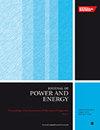Thermal performance and economic sustainability of flat plate solar collectors using MgO and ZnO nanofluids: A comparative analysis
IF 1.1
4区 工程技术
Q3 ENGINEERING, MECHANICAL
Proceedings of the Institution of Mechanical Engineers, Part A: Journal of Power and Energy
Pub Date : 2023-10-18
DOI:10.1177/09576509231207154
引用次数: 0
Abstract
Considering the higher outlet temperature, the present study assessed the performance of Zinc oxide (ZnO) and Magnesium oxide (MgO) nanofluid-based flat plate solar collector at a low volumetric flow rate, that is, 30 L/h. The lower solar irradiance results in a low percentage enhancement in collector efficiency; therefore, it constraints the use of the nanofluid-based collector at such conditions. The collector efficiency was nearly 67.98% and 65.22% for 1 vol% ZnO and 0.2 vol% MgO, respectively, almost 20.57% and 16.53% more than base fluid (ethylene glycol: distilled water). For 1 vol% ZnO and 0.2 vol% MgO, the heat absorption parameter intensified by 20.48% and 17.12%, respectively. The payback period at the optimum concentrations of ZnO and MgO nanofluid-based flat plate solar collector compared to electric heating was ∼2.97 and 3.69 years, respectively. In terms of present worth, the cost savings in a life span of 15 years was approximately 1918.18 and 1839.05 USD for 1 vol% ZnO and 0.2 vol% MgO, respectively. Such gains could be extended using large-sized areas of collectors. The 1 vol% ZnO at the flow rate of 30 L/h has the shortest payback period and highest cost-saving; hence, profoundly recommended in the flat plate solar collector instead of the base fluid.MgO和ZnO纳米流体平板太阳能集热器的热性能和经济可持续性:比较分析
考虑到较高的出口温度,本研究评估了氧化锌(ZnO)和氧化镁(MgO)纳米流体基平板太阳能集热器在低体积流量(30 L/h)下的性能。较低的太阳辐照度导致集热器效率的低百分比提高;因此,它限制了纳米流体集热器在这种条件下的使用。对于1 vol% ZnO和0.2 vol% MgO,捕集效率分别接近67.98%和65.22%,比底液(乙二醇:蒸馏水)高出20.57%和16.53%。当ZnO含量为1 vol%, MgO含量为0.2 vol%时,吸热系数分别提高了20.48%和17.12%。与电加热相比,ZnO和MgO纳米流基平板太阳能集热器在最佳浓度下的投资回收期分别为~ 2.97和3.69年。就现值而言,1 vol% ZnO和0.2 vol% MgO在15年的使用寿命中分别节省约1918.18和1839.05美元。使用大面积的收集器可以扩大这种收益。在30 L/h流速下,1 vol% ZnO的回收期最短,节约成本最高;因此,强烈建议在平板太阳能集热器中代替基液。
本文章由计算机程序翻译,如有差异,请以英文原文为准。
求助全文
约1分钟内获得全文
求助全文
来源期刊

CiteScore
3.30
自引率
5.90%
发文量
114
审稿时长
5.4 months
期刊介绍:
The Journal of Power and Energy, Part A of the Proceedings of the Institution of Mechanical Engineers, is dedicated to publishing peer-reviewed papers of high scientific quality on all aspects of the technology of energy conversion systems.
 求助内容:
求助内容: 应助结果提醒方式:
应助结果提醒方式:


